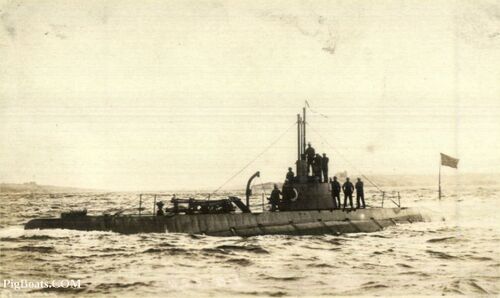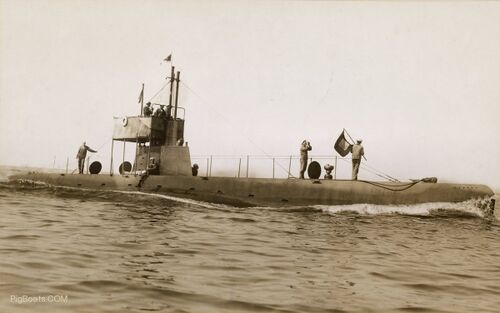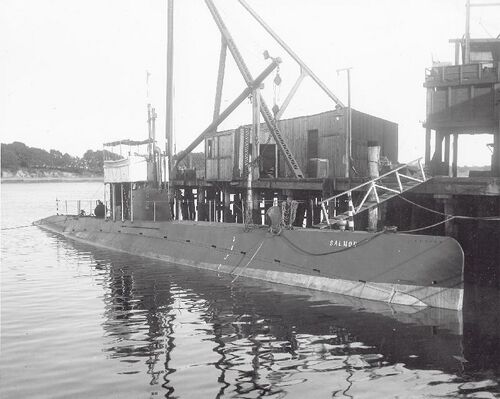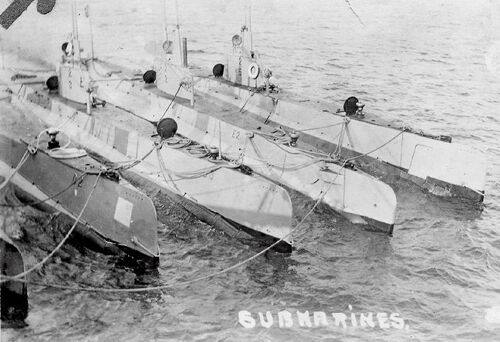D-class: Difference between revisions
Pbcjohnston (talk | contribs) mNo edit summary |
Pbcjohnston (talk | contribs) →Design, Construction, and Naming Notes: Added paragraph on diesels |
||
| Line 1: | Line 1: | ||
[[File:D-Boat Header 1.jpg|center]] | [[File:D-Boat Header 1.jpg|center]] | ||
=== <big>Design, Construction, and Naming Notes</big> === | === <big>Design, Construction, and Naming Notes</big> === | ||
<div style="text-align: justify;"><span style="color:#00008B">The three D-class harbor defense submarines were built to an Electric Boat Company Design at the Fore River Shipbuilding Company in Quincy, MA. They were enlarged C-class boats, and for the first time in a U.S. submarine, the internal space was divided by watertight bulkheads, making these boats more survivable. Narwhal and Grayling had four compartments (torpedo room, forward battery/berthing & control room, after battery/messing, and engine room. Salmon was fitted with only two bulkheads, leaving one large compartment in the middle that made up the forward battery, control room, and after battery. This was done to allow space for a new walk-around periscope, a big improvement over the fixed eyepiece units of the previous boats. All three boats were commissioned in the Navy with their original "fish" names. On November 17, 1911 the Navy changed its naming convention for submarines and these boats were renamed with their D-class names. They had their original general submarine series designations changed to the SS series on July 17, 1920.</span> | <div style="text-align: justify;"><span style="color:#00008B">The three D-class harbor defense submarines were built to an Electric Boat Company Design at the Fore River Shipbuilding Company in Quincy, MA. They were enlarged C-class boats, and for the first time in a U.S. submarine, the internal space was divided by watertight bulkheads, making these boats more survivable. Narwhal and Grayling had four compartments (torpedo room, forward battery/berthing & control room, after battery/messing, and engine room. Salmon was fitted with only two bulkheads, leaving one large compartment in the middle that made up the forward battery, control room, and after battery. This was done to allow space for a new walk-around periscope, a big improvement over the fixed eyepiece units of the previous boats. | ||
All three boats were commissioned in the Navy with their original "fish" names. On November 17, 1911 the Navy changed its naming convention for submarines and these boats were renamed with their D-class names. They had their original general submarine series designations changed to the SS series on July 17, 1920. | |||
In early 1918 the perceived need for submarines to support the war effort pushed the Navy to consider re-engining the D-class boats with diesels. After a bit of bureaucratic waffling, the effort was approved. Electric Boat's engine subsidiary NELSECO was already at capacity so the Lyons-Atlas Engine Company of Indianapolis was sub-contracted to build an eight cylinder, 240 bhp engine for the effort. These Model 120-V4FS engines were built and sent off to the Philadelphia Navy Yard where the work was performed. D-1's re-engining was completed in October 1918, but the end of the war the next month deflated the need and D-2 and D-3's work was not completed until early 1919. | |||
The newer and better engines could not change the fact that tactics and technology had rendered the D-class boats largely obsolete by the early 1920's, and they were all placed in reserve in 1921, never to return to active service. They were scrapped a year later. | |||
</span> | |||
[[File:Red bar sub new.jpg]] | [[File:Red bar sub new.jpg]] | ||
Revision as of 12:16, 25 September 2024

Design, Construction, and Naming Notes
All three boats were commissioned in the Navy with their original "fish" names. On November 17, 1911 the Navy changed its naming convention for submarines and these boats were renamed with their D-class names. They had their original general submarine series designations changed to the SS series on July 17, 1920.
In early 1918 the perceived need for submarines to support the war effort pushed the Navy to consider re-engining the D-class boats with diesels. After a bit of bureaucratic waffling, the effort was approved. Electric Boat's engine subsidiary NELSECO was already at capacity so the Lyons-Atlas Engine Company of Indianapolis was sub-contracted to build an eight cylinder, 240 bhp engine for the effort. These Model 120-V4FS engines were built and sent off to the Philadelphia Navy Yard where the work was performed. D-1's re-engining was completed in October 1918, but the end of the war the next month deflated the need and D-2 and D-3's work was not completed until early 1919.
The newer and better engines could not change the fact that tactics and technology had rendered the D-class boats largely obsolete by the early 1920's, and they were all placed in reserve in 1921, never to return to active service. They were scrapped a year later.
Narwhal/D-1 (Submarine No. 17, later SS-17)

Grayling/D-2 (Submarine No. 18, later SS-18)

At the top of the photo can be seen the boat's periscopes. These are fixed height periscopes meaning they neither raise or lower but they do rotate. They are positioned so both can be used at the same time and not interfere with the view of the other.
Between them is the ship's air operated whistle. At the top of the #2 periscope is the Submarine Division Three Pennant meaning she is the SUBDIV THREE flagship. Normally this is where the submarine's commissioning pennant would be flown from.
Also attached to the #2 periscope, since it neither raises nor lowers, is a small yardarm with hoists for signal flags to be flown from. Heavy stays can be seen fore and aft holding the periscopes rigid and preventing the barrels from warping, destroying the optics.
Salmon/D-3 (Submarine No. 19, later SS-19)

General D-class photos

See more General D-class photos.
Page created by:
Ric Hedman & David Johnston
1999 - 2023 - PigBoats.COM©
Mountlake Terrace, WA, Norfolk, VA
webmaster at pigboats dot com